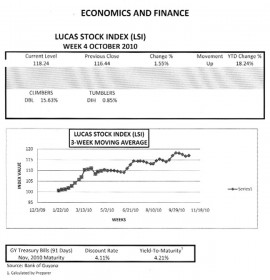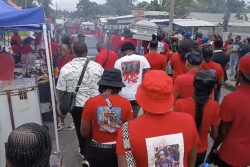Feeling It
What does the structure of the Guyana economy tell us about the ability of Guyanese to serve customers and keep a smile? It tells us plenty about the economic challenges facing Guyanese and the difficulty that many working in the service sector are likely experiencing in trying to keep image while serving fellow citizens. According to the Guyana Bureau of Statistics, the per capita income of Guyana is around US$2,309, and the administration contends that economic activity is increasing. Inflation is estimated at 3.6 percent and Guyanese have access to loans to make purchases. These changes have been accompanied by a shift in workers from the non-service sector to the service sector. There is no doubt that the Guyana economy has gone through significant changes since the early 1990s, but those changes might not be exerting as positive an influence on the economic and social circumstances of most Guyanese as needed. It is likely to be a surprise to some, except those who are living it, that, despite the rosy economic numbers and massive spending on infrastructure, the vast majority of Guyanese operating in the service sector might not be feeling the supposed energy of the economy.
Ruinous Floods
The shift to the service sector has affected agriculture the most and it no longer reigns supreme. Income in this sector is down dramatically from where it was in the 1990s. From 1990 to 1999, agriculture accounted for 45 percent of the income that Guyanese earned. The downward pressure on agriculture became evident around 2000 when incomes fell to around 36 percent after averaging more than 45 percent in the previous decade. No doubt the situation has been exacerbated by the ruinous floods of 2005 and 2006 coupled with the loss of confidence in the reliability of the drainage and irrigation facilities that farmers rely on to produce a good harvest. Even with the floods, agricultural workers did not experience their worst year until 2009 when they accounted for 27 percent of the income earned by Guyanese. Incomes for this category of workers have fallen 36 percent since 1990 and 24 percent since 1999. It comes as no surprise that workers continue to leave this sector of the economy in search of better fortune.
Challenges
The options for Guyanese workers might not be that great. In an earlier reporting on this matter, the Guyana Bureau of Statistics noted that an increasing number of Guyanese were moving into the service sector in search of a living. The preference, it noted, was for Guyanese to move into the wholesale and retail trade. Many Guyanese also sought their fortunes in the transport and communication sector while others engaged in providing repair services for different kinds of products. It is this shift to the service sector that offers the most dramatic evidence of the depth of the economic challenges that Guyanese face.
Division
The service sector is by no means a dominant sector in Guyana, yet its importance to the economy cannot be denied. According to the Guyana Bureau of Statistics, the service sector is that part of the economy that is not involved in agricultural production, mining, manufacturing and construction. This discussion ignores the role of government in the service sector. The division of the economy between service and non-service sector reveals that the service sector accounts for less than 30 percent of the income earned by Guyanese.
No Match
In 1990, the service sector accounted for 29 percent of the earned income in Guyana, and during the nineties, incomes in this sector averaged 21 percent. Things changed in the decade of the 2000s when incomes in the service sector showed a slow but steady rise, reaching as high as 32 percent in 2008 before falling back to 25 percent in 2009. Incomes averaged 25 percent from 1999 to 2009, suggesting that the Guyana economy did not experience significant changes in its structural makeup of earlier times. The service sector is no match for the non-service sector that produces tangible goods such as forest products, manufacturing, mining and even houses. That part of the economy is responsible for generating as much as 56 percent of the income in the country, or twice as much as the service sector.
Anomaly
The slight increase in income in the service sector therefore could hardly be considered enough to compensate the workers operating in that area of the economy. The Guyana Bureau of Statistics estimated that over 53 percent of Guyanese have been working in the service sector since 2002. Yet, that sector has only been bringing in an estimated 25 percent of the income earned in Guyana. In contrast to the earlier time period of the nineties, the ratio of income to workers has not changed much. During the nineties, 46 percent of the workers brought in about 22 percent of the income. It is thus something of an anomaly to see an increasing number of workers move to the service sector, even though it does not produce attractive levels of income.
It is not clear what is causing the shift of workers from the non-service sector to the service sector. What is obvious is that the service sector is not operating with a high level of efficiency, suggesting that it might be relying too much on unskilled workers for its survival. The most one can expect under those circumstances is service without a smile.








